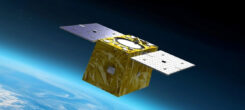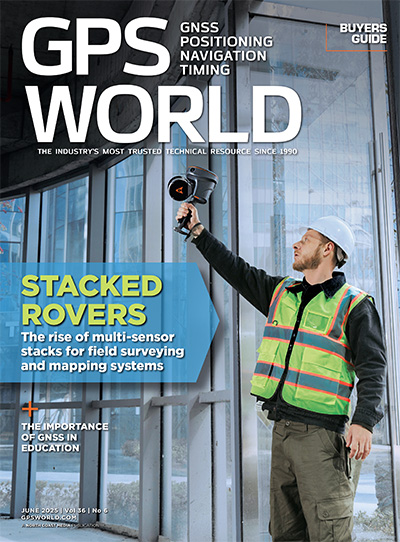Interoperability in GNSS Systems

During the Definition Phase of Galileo, the European Commission (EC) has often cited a high degree of “interoperability” with contemporary systems as a major system design goal. But what exactly is “interoperability?”
 |
The range of systems mentioned as candidates for interoperability is quite wide, including GPS, GLONASS, the European Geostationary Overlay Service (EGNOS) and other satellite-based augmentation systems (SBAS), Loran-C, Eurofix, and UMTS. However, there are many more, including other navigation systems and a variety of vehicle systems.
Galileo/GPS interoperability discussions are already underway between the United States and the EC, and a major EC study into Galileo’s interoperability potential is now being conducted. However, the word “interoperability” is not uniquely defined and carries different meanings to the many people involved.
Furthermore, we also hear of a requirement for “compatibility,” but often there is an almost identical spectrum of requirements behind that word. There is even further talk about “integration,” again carrying similar themes in the definitions. Some agencies have already agreed rigid definitions of the terms – and that’s fine – but when two agencies with different definitions meet to discuss the topic, all too often the fundamental purpose of the meeting gets lost in a lengthy and pointless semantic debate.
Therefore, let us abandon the semantics and attempt to create a structure that will assist a clear view of the real problems, whilst grouping the entire topic under the single name “interoperability” for no other reason than that’s the side of the coin that landed up!
Clearly it makes sense for Galileo to work harmoniously with as many sensible candidate systems as possible. The “sensible candidate” caveat is necessary because a moment’s thought reveals that, in theory at least, just about anything could be made interoperable with GNSS if time and money were no object. In the practical world, however, we should concern ourselves only with those systems whose integration with Galileo would lead to an affordable combination, for which a real user need exists.
The definition of GNSS interoperability should therefore consist of a two-step analysis:
- 1. Defining a methodology to structure the analysis of the possible interoperability issues
- 2. Defining a methodology for ascribing a value, and therefore a priority, to the interoperability opportunities identified.
Interoperability Issues
Let us begin to create a coherent analysis methodology for Galileo’s interoperability by placing the Galileo receiver (and here we must include the antenna within the definition of the receiver) at the heart of a layered system. This is a reasonable approach since the Galileo receiver is the first active part of the user segment to interact with the Galileo signal. The receiver has two basic functions: it receives/decodes the Galileo radio frequency (RF) signal and it processes the data resident on that signal to produce position, velocity and time information.
 |
This basic two-part receiver may be a stand-alone application, or integrated into a multi-layer system. For example:
- 1. It may be integrated with information from other navigation systems to provide an integrated or filtered navigation solution.
- 2. The integrated navigation solution may further be integrated into a navigation/communication system.
- 3. The navigation/communication system may be integrated into a vehicle. For example, in a car all the systems may be integrated: position, communications, lights, and so on.
- 4. The next levels could span “vehicle fleet,” “transport sector,” “geographic region,” “institutional regime,” and so forth, but for the purposes of the analysis, especially to keep the analysis to a manageable size, the “concept of use” layer will cover all these aspects. Here, a “concept of use”could be, for example, commercial truck fleets in Europe, or civil aviation in South America.
Only At Its Level. Having created a logical structure of integrated application layers, we must now identify the interoperability opportunities at each layer, defined here as “Interoperability levels” and – this is the important point – interoperability can only take place at its appropriate level.
Figure 2 shows the main interoperability opportunities for Galileo at each level. Note that the “Receiver” layer is split into two levels. Conceptually, it might be possible to split other layers into separate levels (especially the “Concept of use” layer) – but this article will not pursue that option further.
The interoperability candidate list at each level is not exhaustive and will accommodate emerging requirements as studies progress. Levels 1 to 5 interoperability will be mainly technical by nature; Level 6 interoperability studies will require an approach tailored to the concept under study, and will contain technical, legal, business and institutional issues (structured sub-levels could be constricted on a case-by-case basis).
Interoperability With 3G. Perhaps a good example of the use of the diagram is to analyse the stated EC requirement for Galileo to be interoperable with third generation cellular phones (UMTS). Interoperability in this case could be analysed at the six levels:
1. For interoperability at level 1 in an integrated UMTS/Galileo system, the UMTS RF signals should not interfere with Galileo.
2. At level 2, UMTS could carry Galileo differential or integrity messages. Also, UMTS could assist positioning inside buildings by using the UMTS system to carry up-to-date satellite ephemeris data.
3. At level 3, position deduced from trilateration of the UMTS signal could be mixed with the Galileo-derived position in a navigation filter.
4. At level 4, the UMTS link could be used to link position-related data, such as maps or advertising.
5. At level 5, interoperability is probably not necessary for UMTS.
6. Finally, at level 6 there is the question of any legal or institutional constraints that may be involved in the concept of use.
- 1. Frequency ������ Although in essence a simple technical issue, this issue will be characterized by negotiation and international agreement.
- 2. Signal structure will be as important as frequency. Signal data rates impact bandwidth.
- 3. Data formats should be compatible for ease of interoperability.
- 4. Candidate common commercial interfaces will need to be identified.
- 5. At level 6, legal, institutional, technical and commercial issues will have to be studied.
This is especially evident when one hears discussion of the need for Galileo to be interoperable with other navigation systems. Loran-C is an often-cited candidate. Kalman filters are wonderful things, and have been around for many years. They allow the appropriately������weighted combination of any sort of position lines and produce a near-optimal result. As a candidate for use as an input to a navigation Kalman Filter, Loran-C is no different from any other navigation system and would be relatively simple to integrate at level 3. Such integration is well understood by companies who have been doing this sort of thing for years. We suspect that there is some confusion, particularly in the case of Loran-C, because Eurofix uses some Loran signals as a data link medium for level 2 interoperability GNSS differential corrections. There is therefore scope for confusion of level 2 or 3 interoperability for Loran if the requirement is not precisely stated.
This discussion should clarify that the requirement is for Loran-C interoperability at level 3. This approach must be rigorously followed.
Assigning Priorities
The possibilities for Galileo’s interoperability from a theoretical point of view are potentially open-ended. Where should one bound the sensible candidates? The answer surely must be that the set needs to be limited to a manageable level by rules to ensure that there is a powerful social/business reason to pursue interoperability in a particular area, rather than just a technical possibility. The value of interoperability must be measured against a number of criteria, for instance:
- 1. Public good – for example, by making GPS and Galileo’s open access services interoperable, the receiver design for free joint services will be simplified and, in essence, a 60-satellite constellation will provide very high levels of availability.
- 2. Economic – for example greater levels of market penetration for Galileo receivers may be possible if the interoperability capabilities meet the user’s real needs.
- 3. Drawbacks – for example, existing intellectual property rights may hinder the commercial exploitation of some interoperability opportunities. Or, combined terminals may be prohibitively expensive in some cases.
The process works as follows:
- 1. The first round of assessment will require a wide consultation. A preliminary collection and filtering process will result in primary and secondary candidate lists for further examination. Primary candidates will be examined in more detail at this phase.
- 2. The initial assessment needs to be tested, first, with the operators of other systems.
- 3. Next, a broader view needs to be taken. User forums and other experts should run workshops to refine the most favorable opportunities.
- 4. Results to this point should allow a greater level of detail to be extracted for the chosen interoperability opportunities.
- 5. Finally, the main candidates should be ranked and prioritized, and action plans need to be created for implementation of interoperability at the right level and with the right systems in the next phases of the Galileo project.
What Next?
The EC’s Compatibility study has just started; the principal contractor is Thales ATM, Germany, under the leadership of Arian Leonard, and the above methodology is being used. The study team saw the value of the method even at the planning stage of the study. Areas of research naturally fell from the identified levels. Importantly, areas where valuable resources should be focused are also easily identified. No doubt the study will refine the approach as it progresses.

















Follow Us